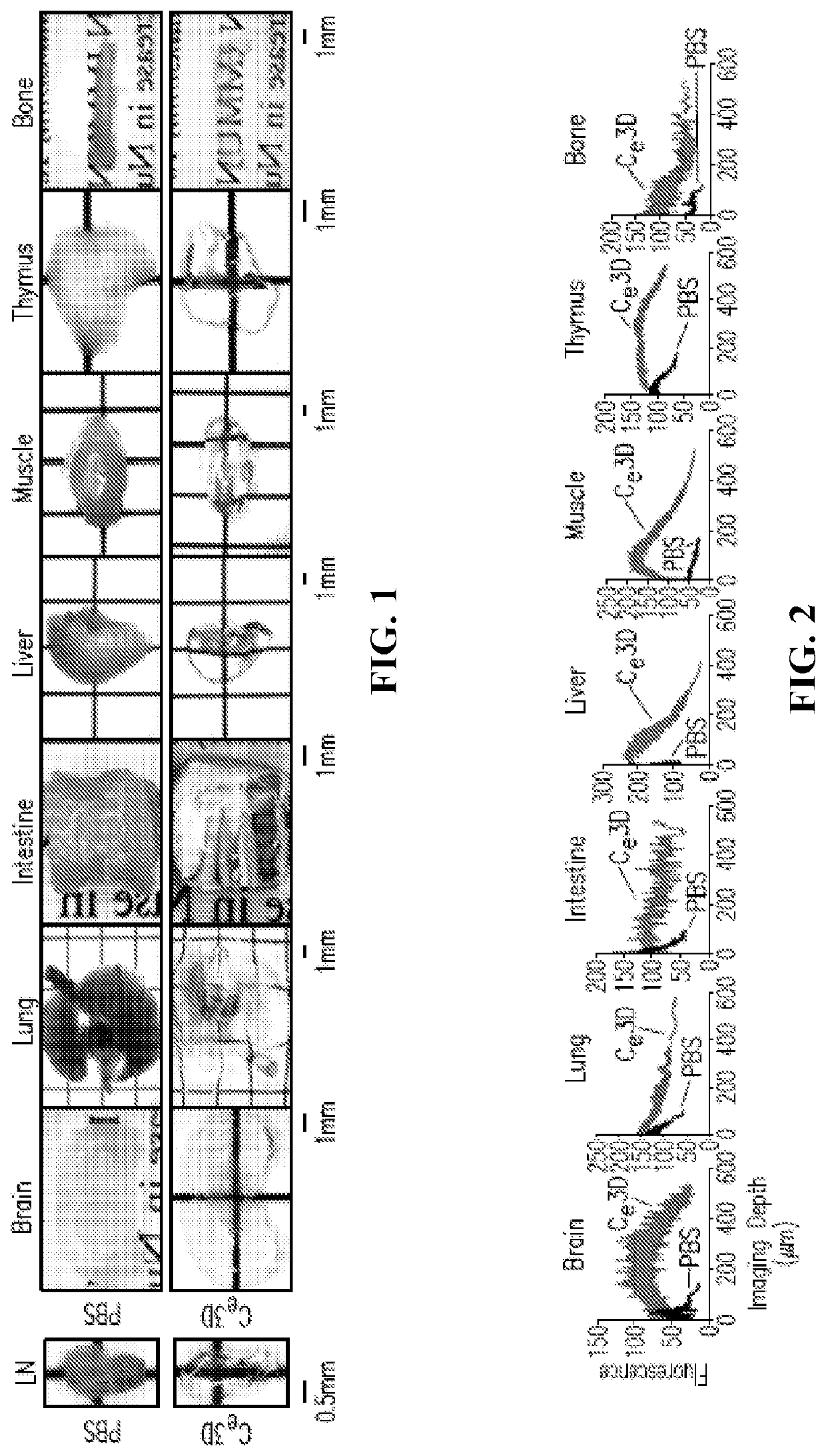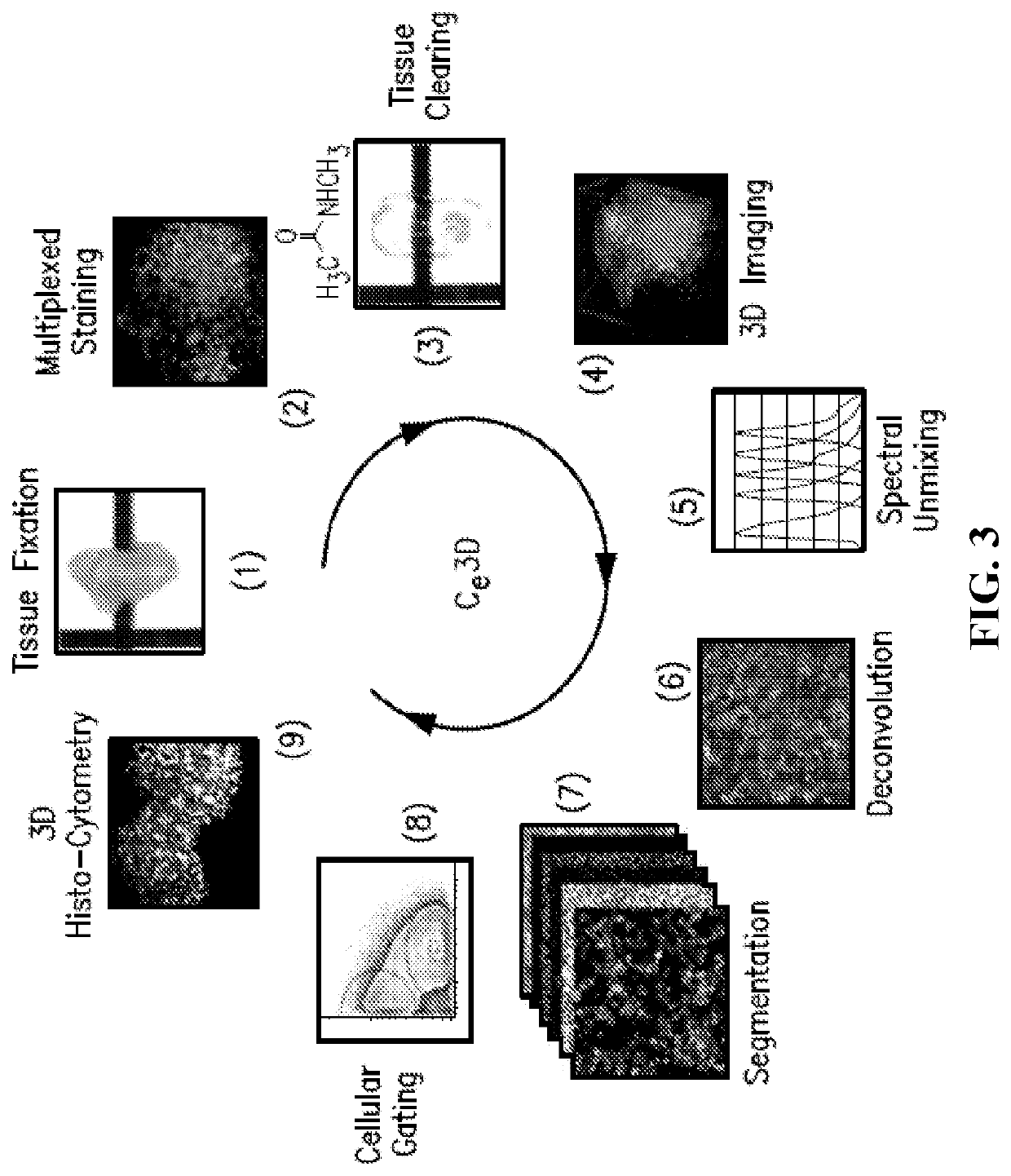Method and composition for optical clearing of tissues
a tissue and optical clearing technology, applied in the field of tissue optical clearing, to achieve the effect of excellent tissue transparency, high resolution, and convenient us
- Summary
- Abstract
- Description
- Claims
- Application Information
AI Technical Summary
Benefits of technology
Problems solved by technology
Method used
Image
Examples
example 1
[0161]This example demonstrates the improved clearing of tissues, including preservation of cellular morphology, reporter fluorescence and epitope labeling, when tissues are treated in accordance with embodiments of the invention. In this example, mouse tissues were cleared, stained, and imaged in accordance with embodiments of the invention. The specific details of this experiment are as follows.
[0162]Mice: CD11c-YFP (B6.Cg-Tg(Itgax-Venus)1Mnz / J), actin-DsRed (B6.Cg-Tg(CAG-DsRed*MST)1Nagy), Cxcl12-DsRed (Cxcl12tm2.1Sjm / J), Cx3cr1-GFP (B6.129P-Cx3cr1 tm1Litt / J) and Histone GFP-tagged reporters (B6.Cg-Tg(HIST1H2BB / EGFP)1Pa) were obtained from Jackson Laboratories. Fluorescent Confetti animals were generated by crossing B6.129P2-Gt(ROSA)26Sortm1(CAG-Brainbow2.1)Cle / J×B6.Cg-Tg(UBC-cre / ERT2)1Ejb / 2J Jackson Laboratories). Mice heterozygous for both transgenes were injected intraperitoneally with tamoxifen 100 micrograms per gram of body weight in peanut oil (Sigma Aldrich) for five conse...
example 2
[0175]This example demonstrates an improved method of clearing of lipid-rich tissues, including preservation of cellular morphology, reporter fluorescence and epitope labeling, when tissues are treated in accordance with an embodiment of the invention.
[0176]In this example, mouse brain tissue was cleared, stained, and imaged in accordance with Example 1 except as indicated for the following: (1) 1×BD Perm / Wash™ buffer (available from BD Biosciences) was used instead of BD Peimeabilization buffer for tissue washing; and (2) 1% BSA and normal mouse serum in 1×BD Perm / Wash™ was used as the blocking and antibody dilution buffer. BD Penn / Wash™ is a saponin containing buffer which also includes sodium azide and Fetal Bovine Serum.
[0177]This method provides improved clearing of tissue that are lipid-rich, such as brain tissue, by using a commercially available (e.g., one available from BD Biosciences) saponin-based surfactant.
example 3
[0178]This example demonstrates the improved clearing of fat-rich tissues, including preservation of cellular morphology, reporter fluorescence and epitope labeling, when tissues are treated in accordance with an embodiment of the invention.
[0179]In this example, mouse mammary gland tissue was cleared, stained, and imaged in accordance with Example 1 except as indicated below.
[0180]After fixation, samples were incubated at room temperature for one hour each in 50%, 80%, 95%, 100% of acetone (acetone was diluted in water). The incubation 100% acetone can be extended to 1 to 3 days (at room temperature) depending on the size of sample. Then the samples were incubated in 95%, 80%, 50% of acetone for 1 hour at room temperature, and finally in PBS.
[0181]The 3D structure of ducts of the mouse mammary glands were visualized by Ce3 D clearing. The directly conjugated antibody (Alexa Fluor 647) for E-cadherin was used to stain ducts, dendritic cells were visualized by endogenous expression o...
PUM
 Login to View More
Login to View More Abstract
Description
Claims
Application Information
 Login to View More
Login to View More - R&D
- Intellectual Property
- Life Sciences
- Materials
- Tech Scout
- Unparalleled Data Quality
- Higher Quality Content
- 60% Fewer Hallucinations
Browse by: Latest US Patents, China's latest patents, Technical Efficacy Thesaurus, Application Domain, Technology Topic, Popular Technical Reports.
© 2025 PatSnap. All rights reserved.Legal|Privacy policy|Modern Slavery Act Transparency Statement|Sitemap|About US| Contact US: help@patsnap.com



